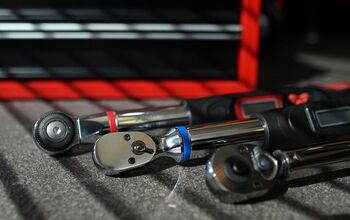Beware: Mysterious Phenomenon Can Blow Your Engine to Bits

Deep inside of your vehicle’s engine, a teensy little spark from the spark plug ignites precisely measured squirts of gasoline many times per second. This results in a rapid and continual series of tiny and controlled explosions that are contained entirely within the engine’s cylinders.
Your engine turns the force from these little explosions into the miracle of momentum. Now you know how an engine works.
For all of this business to work properly, the tiny little explosions need to happen with incredibly precise timing each and every time. It’s a tall order: the explosions occur in measures of milliseconds. It’s the spark plug that’s responsible for setting them off and for keeping the timing of these explosions under control.
But sometimes, the timing gets mucked up. Making gasoline explode requires heat from the spark from the spark plug — but the spark plug isn’t the only source of heat inside of your engine’s cylinders. Sometimes, when things go wrong, the inside of your engine gets too hot and the gasoline explodes out of turn before the spark plug tells it to.
In this situation, the little explosion sort of jumps the gun. This is called engine knock and it can turn your engine into soup. Thankfully, engine knock is very predictable, well understood, and so well-studied that modern engines are fitted with systems that prevent it from occurring at all. If you have a modern vehicle that’s well maintained and running quality gasoline at the right octane level, engine knock is something you needn’t spend any time worrying about.
What is Low-Speed Pre-Ignition?
Scientists have recently discovered that engine knock has a mysterious evil twin. It’s called Low-Speed Pre-Ignition (LSPI), and it’s serious and destructive. Even scarier? Experts like Scott Lindholm, the Global Product Application Specialist for Shell Lubricants, don’t yet fully understand what causes it.
“Knock and LSPI are two distinct events, caused by two different phenomena,” Lindholm explains. “Typical knock can be controlled by fuel octane and spark timing and is very predictable. LSPI is still not well understood and can occur very randomly.”
ALSO SEE: 8 Important Tips for Buying a Used Luxury Car
Both LSPI and typical knock result when gasoline in the cylinders ignites at the wrong time though the conditions surrounding each phenomenon are different.
Knock characteristically occurs at higher RPMs and under higher load when your engine is hot and stressed and working hard. But LSPI can happen at very low RPMs and under a lighter load. It also likes to happen in the sort of operating range where high fuel efficiency is obtained in modern engines. Unlike engine knock, LSPI is very unpredictable.
Who Is Susceptible to Low-Speed Pre-Ignition?
Here’s the kicker: LSPI seems to love popping up in today’s rapidly proliferating breed of small turbocharged and Direct-Injected (TGDI) engines. It’s becoming harder and harder these days to find a vehicle that isn’t powered by this type of engine since many automakers are switching to TGDI engines to trim fuel consumption.
Translation? Many new car engines are welcoming homes for dangerous LSPI.
What Does LSPI Do?
What happens to an engine when LSPI arrives to crash the party? Nothing good.
Lindholm explains: “The effect of LSPI can be heard as a loud bang, which most would describe as super knock. However, due to the timing and severity of some of the events, engine damage has been noted. LSPI leads to much higher cylinder pressures than traditional engine knock, up to 200 bar or even higher. Piston tops can crack, rings can break and scuff the liner, and cylinder head cracking is possible, too. We’ve actually seen parts of the piston lodging between the top of the piston and the cylinder head.”
In human terms, you might picture LSPI as the vehicular equivalent of a small bomb detonating inside of your heart. Put simply, LSPI can quickly turn the inside of your engine into confetti, killing it with zero notice.
Should you be worried? Maybe, but probably not.
Here’s the thing: though engineers still don’t know exactly what causes LSPI, they do know the specific conditions where it likes to occur within the operating range of a TGDI engine. Through programming of the computer systems that operate the engine, these conditions can be avoided.
“It is common — in the sense that essentially all TGDI engines can experience LSPI — though it is being controlled by careful calibration of operating parameters by the OEM to avoid the conditions where LSPI likes to occur. So it is, and has been, a real field event that can be reproduced in the laboratory under careful supervision,” Lindholm explains.
Lindholm says he has no concerns about owning a modern car with a TGDI engine since automakers have been successfully calibrating engine software to avoid operation in the LSPI danger zone.
“Engine calibrations are very complex and exact and OEMs have a thorough understanding of what engine conditions can cause damage via LSPI [or other conditions], so they make sure that those conditions are avoided,” he says.
ALSO SEE: Top 10 Best Engines of 2018
Once LSPI is understood more fully, it may be possible to eliminate it. From here, the consumer may stand to benefit from improved fuel efficiency. In simple terms, the LSPI-prone operational conditions currently being avoided via engine programming can overlap some of the operational conditions where the TGDI engine gets its best fuel efficiency. With a better understanding or elimination of LSPI, cautious engine programming may be relaxed so that the engine can operate in a wider window of conditions — including conditions where fuel efficiency is improved.
What Causes Low-Speed Pre-Ignition?
Lindholm and his team are working with automakers to dig deeper into the causes of LSPI, and they may be getting closer to an answer.
“One theory is that small [hot] oil droplets are thrown off the piston rings at top ring reversal, presenting a possible ignition source other than the spark plug. That being said, motor oil formulation can help reduce LSPI tendencies,” he says.
In plain English, this theory suggests that rogue drops of extremely hot engine oil may be launched into the cylinders at the wrong time, kicking off the gasoline explosion prematurely and resulting in LSPI.
Lindholm says that working on engine oil formulations seems promising. “Even though we don’t know the exact cause of LSPI,” he said, “we do know that oil formulation can help reduce or eliminate it in the tests we have now.”
ALSO SEE: 3 Warning Lights That Mean ‘Stop Driving RIGHT NOW’
One of these tests has been developed and sponsored by Ford, which is one of many automakers to offer TGDI engines in the majority of vehicles they sell. The Ford LSPI test is being used to help experts like Lindholm develop upcoming motor oil formulations. Though not available yet, these new engine oil formulations are in the works and will include protection against numerous engine problems, including LSPI, when they are released.
“GF-6 is the next industry engine oil specification that has been under development for years,” Lindholm explains. “It is due to be introduced in the next year or two and incorporates a number of tests that measure motor oil performance characteristics such as sludge prevention, deposit protection, fuel economy, anti-wear, and now, LSPI, along with other performance parameters.”
Lindholm says he and his team will continue to research the exact chemical and mechanical processes responsible for LSPI in hopes of creating a motor oil formulation that can eliminate it — which may give consumers further improved efficiency in the process.

Justin Pritchard, an award-winning automotive journalist based in Sudbury, Ontario, is known for his comprehensive automotive reviews and discoveries. As a presenter, photographer, videographer, and technical writer, Justin shares his insights weekly through various Canadian television programs, print, and online publications. In 2023, Justin celebrated a significant milestone, airing the 600th episode of his TV program, AutoPilot. Currently, he contributes to autoTRADER.ca, Sharp Magazine, and MoneySense Magazine. His work as a technical writer, videographer, presenter, and producer has been recognized with numerous awards, including the 2019 AJAC Video Journalism Award and the 2018 AJAC Journalist of the Year. Justin holds a Bachelor of Commerce (Hons) from Laurentian University, which he earned in 2005. His career in automotive journalism began that same year at Auto123.com. Since then, he has written one of the largest collections of used car buyer guides on the internet. His passion for photography, nurtured from a young age, is evident in his work, capturing the scenic beauty of Northern Ontario. Living in a region with a particularly harsh winter climate has made Justin an expert on winter driving, winter tires, and extreme-weather safety. Justin’s significant achievements include: 2019 AJAC Video Journalism Award (Winner) 2019 AJAC Road Safety Journalism Award (Runner-Up) 2019 AJAC Automotive Writing (vehicle review topics) (Winner) 2019 AJAC Automotive Writing (technical topics) (Winner) 2018 AJAC Journalist of the Year You can follow Justin’s work on Instagram @mr2pritch and YouTube @JustinPritchard.
More by Justin Pritchard

































Comments
Join the conversation
in other words: don't fill a can with 86 octane in Nevada then pour it in your Si in Death Valley